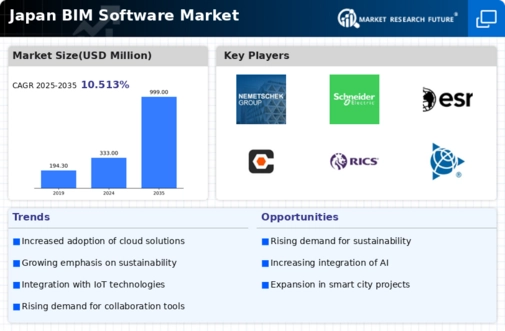Rising Focus on Project Efficiency
The emphasis on improving project efficiency within the construction sector is a significant driver for the bim software market. Companies are increasingly recognizing the benefits of utilizing bim software to optimize workflows, reduce costs, and enhance overall project delivery. In Japan, where project timelines and budgets are often tight, the ability to streamline processes through bim technology is becoming essential. Studies indicate that firms using bim software can reduce project delivery times by up to 30%, which is a compelling incentive for adoption. As competition intensifies, construction companies are likely to invest in bim solutions that offer robust project management capabilities. This focus on efficiency not only supports the growth of the bim software market but also encourages innovation and the development of new features tailored to meet the evolving needs of the industry.
Regulatory Compliance and Standards
The stringent regulatory environment in Japan is likely to influence the bim software market significantly. Compliance with local building codes and safety regulations necessitates the use of advanced software solutions that can ensure adherence to these standards. The Japanese government has established various guidelines aimed at improving construction quality and safety, which in turn drives the demand for bim software that can facilitate compliance. For instance, the Ministry of Land, Infrastructure, Transport and Tourism has been promoting the use of bim technologies to enhance project efficiency and safety. As a result, construction firms are increasingly investing in bim software to meet these regulatory requirements, which could lead to a market growth rate of around 6% annually. This trend suggests that the bim software market will continue to expand as companies seek to align with evolving regulations.
Growing Demand for Skilled Workforce
The increasing complexity of construction projects in Japan has led to a growing demand for a skilled workforce proficient in bim software. As the industry evolves, there is a noticeable shift towards hiring professionals who are adept at utilizing advanced bim tools. This trend is likely to drive the bim software market as companies invest in training and development programs to enhance their employees' skills. According to recent studies, approximately 70% of construction firms in Japan report difficulties in finding qualified personnel with bim expertise. This skills gap may compel organizations to adopt more user-friendly bim software solutions that require less specialized training, thereby broadening the market's appeal. Consequently, the bim software market may witness increased growth as firms seek to equip their workforce with the necessary tools to meet project demands.
Increased Investment in Infrastructure
Japan's ongoing investment in infrastructure development is a crucial driver for the bim software market. The government has allocated substantial budgets for various infrastructure projects, including transportation, energy, and urban development. For instance, the 2025 budget includes an increase of 10% for infrastructure projects, which is expected to boost the demand for efficient project management tools like bim software. As these projects become more ambitious and complex, the need for advanced bim solutions that can streamline processes and enhance collaboration among stakeholders is likely to grow. This trend indicates that the bim software market could experience a surge in demand, potentially reaching a valuation of $1 billion by 2030. The focus on infrastructure development not only supports economic growth but also drives technological adoption in the construction sector.
Technological Advancements in Construction
The rapid evolution of technology within the construction sector appears to be a primary driver for the BIM Software Market. Innovations such as artificial intelligence, machine learning, and cloud computing are increasingly integrated into bim solutions, enhancing their functionality and usability. In Japan, the construction industry is projected to grow at a CAGR of approximately 5.2% from 2025 to 2030, indicating a rising demand for advanced bim software. These technologies facilitate real-time collaboration and data sharing, which are essential for efficient project management. As construction projects become more complex, the need for sophisticated bim software that can handle intricate designs and workflows is likely to increase, thereby propelling market growth. Furthermore, the integration of Internet of Things (IoT) devices with bim software is expected to provide valuable insights into project performance, further driving adoption.





















Leave a Comment